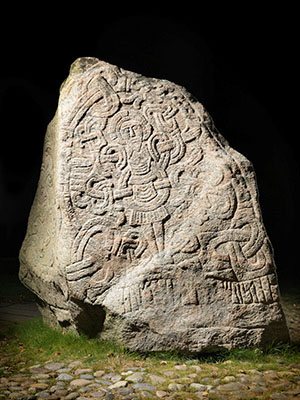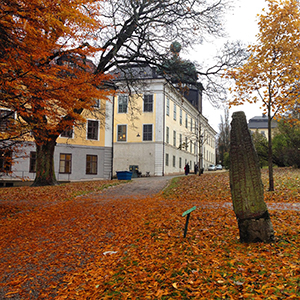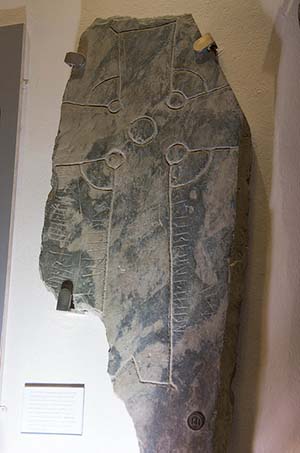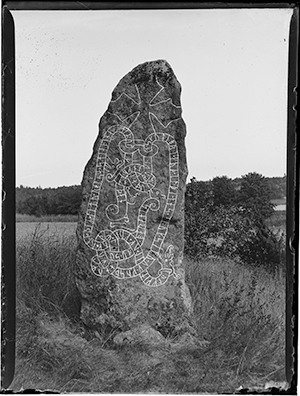Since we are in the season of Lent, I thought it appropriate to write a blog post on runestone Christianity. A very common misconception about the over 3.000 runic monuments from the Viking Age is that they are pagan, whereas almost the exact opposite is true. Runestones are either explicitly Christian by the means of a cross and/or the inclusion of a prayer, or seemingly religiously neutral. Although the latter inscriptions are more common than the former, there is reason to believe that almost all of them, too, are commissioned by and for Christians.
runestones give evidence not of the official teachings but of the received piety
Even though the Christian influence on runestones has been recognized since the early 18th century, most researchers seem to view the religious expressions as quite primitive and typical of first generation converts. What is forgotten, however, is that runestones give evidence not of the official teachings but of the received piety. We see little of church hierarchy or of theological sophistry, but more of “practical” Christianity. These are memorials, after all, best compared to gravestones in our modern world.
That is why three celestial personages are mentioned, and no one else. These are the ones that according to Catholic dogma were important to please at the last judgment: Christ of course, but also his mother the Virgin Mary who intercedes on behalf of the souls to be judged and the archangel Saint Michael who weighs them in his scales.
The Father and the Holy Ghost are never mentioned explicitly
Missionary theology had to explain the faith in terms understandable to the polytheists they encountered. This explains why the word God primarily seems to have implied the Son. The Father and the Holy Ghost are never mentioned explicitly.
This is the only real evidence of any “primitivism” visible in runestone Christianity. Many of the monuments were commissioned by third or fourth generation Christians. Their faith was most likely as “advanced” as that of other contemporary Europeans. To show that that Viking Age Christians held beliefs in accordance with medieval dogma and received theology, and indeed very much what is also true today, I will show how the runestone prayers directly or indirectly conform to two of the most basic confessions of Christian faith: the Apostles’ creed and the Nicene creed.
Nicene Creed
We believe in one God
- Galteland stone in Norway (N 184): God is one.
Apostles’ Creed
And in Jesus Christ, his only begotten Son, our Lord
- Onchan (Conchan) stone cross on Isle of Man (Br Olsen;194): Jesus Christ.
- Tierp’s church stone in Uppland (U 1143): May the Lord God help the spirits of all Christians.
Nicene Creed
For us and for our salvation he came down from heaven: by the power of the Holy Spirit he became incarnate from the Virgin Mary, and was made man
- Abrahamstorp stone in Västergötland (Vg 122): May God and the holy Saint Mary help …’s soul.
- Över-Järva stone in Uppland (U 126): May God and God’s good virgin help their spirits.

The crucifiction scene on the Jelling runestone in Denmark. Photo: Roberto Fortuna, The National Museum of Denmark (CC BY-SA)
Apostles’ Creed
Suffered under Pontius Pilate; was crucified, dead and buried
The particulars of Christ’s suffering, death and ascension play little or no role in runic inscriptions. But the concept is very much alive, as can be seen from the crucifixion scene on one of the three faces of the Jelling runestone (DR 42).
Nicene Creed
On the third day he rose again in accordance with the Scriptures; he ascended into heaven and is seated at the right hand of the Father. He will come again in glory to judge the living and the dead, and his kingdom will have no end
Christ is risen, as may be seen on the Timmele stone below. There is no mention of the judgement itself, but see the introduction. Nevertheless, there is a keen consciousness of life and death on runestones.
- Timmele graveyard stone in Västergötland (Vg 186): May God and the Mother of God and the Holy Christ in the Kingdom of Heaven help his soul.
Apostles’ Creed
I believe in the holy catholic church: the communion of saints
The creeds’ church refers of course to the institution, not a building. Even the latter are mentioned rarely on Viking Age runestones, but the fact that they are at all proves that there was some sort of ecclesiastical organisation. The saints in general played a small role in Missionary times, with one great exception and some minor. The exception is the archangel Michael, who had a critical function at the last judgement (see the introduction). Some popular saints lent their names to the early generation Christians of Uppland, such as John (the Apostle/Evangelist or the Baptist), Martin (of Tours), Clement (several candidates), and Nicholas (of Myra, the fore-runner of Santa Claus).
- Bjärby stone on Öland (Öl 36): He is buried in the church.
- Hogrän’s church stone on Gotland (G 203): May Saint Michael help his soul.
Nicene Creed
We acknowledge one baptism for the forgiveness of sins
- Sälna stone in Uppland (U 323): May God help his spirit and soul, forgive him his guilt and sins.
- Håga stone in Uppland (U 896): … had the stone raised for the spirit of Öjvind, their son, (who) died in baptismal robes.
Nicene Creed
We look for the resurrection of the dead
The resurrection as such is not mentioned, but the afterlife in more concrete terms is clearly on the minds of the commissioners of at least two inscriptions.
- Risbyle stone in Uppland (U 160): May God and the Mother of God help his spirit and soul; grant him light and paradise.
- Klemensker 1 stone on Bornholm (DR 399): May Christ help Ödbjörn’s soul into light and paradise.
Nicene Creed
And the life of the world to come
- Folsberga stone in Uppland (U 719): May Christ let Tumme’s spirit come into light and paradise and into the best world for Christians






Good article. And a lot of the period rune magic (the Bro crosses, etc.) were Christian, not Pagan. If I see + for skilletegn (separation marks) in an inscription, that means that the carver was Christian.
Hi Jane,
The shape of the separation markers cannot, unfortunately, be used to determine the religion of a runic monument. The Rök stone, for example, has cross-shaped separators but is still very much a Heathen object.
Dear Henrik:
I have been quite interested in the connection that runes have with religious and particularly Christian themes. I have been amazed by the fairly large number of runic inscriptions that refer to the terms ǫnd och sál. The concept of “bridge” for the spirit or soul seems quite important to the rune-writing Christians of medieval times.
Med vennlig hilsen,
David O.N. Johnson
Minnesota